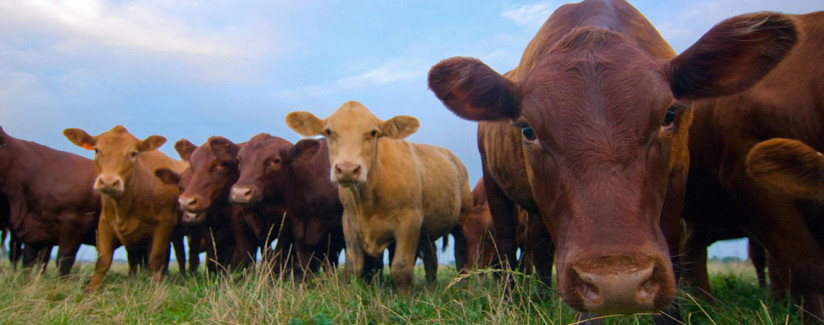
“Food from organic and free-range farm animals is safer than animals raised in modern confinement buildings.”
11/04/2013
The popularity of organic and other niche-market products has increased in recent years primarily boosted by consumer perceptions that they are healthier and of higher quality. There is limited scientific data to support or refute the safety of such products.
Studies have found that pathogen prevalence is actually higher in niche market/ free range antibiotic-free farm animal production systems compared to conventional confinement operations.
For example, a nationwide survey showed that conventionally-labeled milk had the lowest bacterial counts compared to organic systems. A pork-related study found significantly higher prevalence of Salmonella and other pathogens in free-range pigs compared to those raised in confinement systems.
One reason prompting the move to raising certain farm animals indoors beginning a half-century ago was control of pathogens – diseases from parasites in particular. A return to outdoor systems may contribute to reemergence of parasitic pathogens, some of which have been effectively eliminated from food animals.
True or Not? “Elimination of farm subsidies will reduce obesity and associated health problems.”

Wondwossen Gebreyes, DVM, PhD says:
The popularity of organic and other niche-market products has increased in recent years primarily boosted by consumer perceptions that they are healthier and of higher quality. There is limited scientific data to support or refute the safety of such products.
Background and definition: Various food animal production systems are currently practiced in the United States as well as various parts of the world. Some of the terminologies currently used include conventional, organic, antimicrobial-free, sustainable, niche-market, free-range, confined animal feeding operations (CAFO), natural etc. While some of these production types have functional differences, others do not necessarily have significance in the scientific context and could have significant overlaps in management strategies. Organic and conventional food production systems are the two systems (as well as terminologies) that are most commonly referred both in animal and plant based food productions. For the sake clarity and consistency, this article is mainly focused on these two types: organic (loosely defined as free-range, niche-market, antimicrobial-free and intensive/ confinement (commonly referred as conventional) food animal production systems with specific emphasis on “safety” attributes.
Organic production is broadly defined as food produced by farmers who emphasize the use of renewable resources. Organic food is produced without using pesticides; fertilizers made with synthetic ingredients and animals that are given no antibiotics, ionophores, growth hormones or mammalian byproducts. These products are required to have a USDA certification following the standards set forth by the Organic Foods Production Act of 1990 (see USDA National Organic program). On the other hand, the common and conventional food production is currently produced in intensive (also referred as confined) housing and with processed feed additives including antibiotics and macronutrients. While there is a considerable boost in production of organic/ niche-market products in recent years in the U.S. and Europe, mainly tied to consumer perception of higher quality (healthier, better tasting) food in organic production, there are limited scientific data to support or refute of the “safety” of such products. As majority of the reported safety attributes focus on biological hazards (pathogen) prevalence and associated issues, particularly antimicrobial resistance, main emphasis is given to this aspect.
Foodborne pathogens and antimicrobial resistance: Various parasitic and bacterial pathogens of public health significance are commonly associated with food animal production systems. While the parasitic diseases are still of very high significance in the under developed world, their significance had been diminished significantly paralleling the expansion of confined conventional production systems in the industrialized world half a century ago. On the other hand, bacterial pathogens such as Salmonella and Campylobacter, are known to be common in conventional production systems. Antimicrobials have been used to control public and animal health important bacterial pathogens as well as animal production purposes since the introduction of confined systems. Several classes of antimicrobials to which there are human medicine analogues are commonly used as feed additives for growth promotion purposes and for prevention of infectious agents. Regardless of the types of use (therapeutic, prophylactic or growth promotion), antimicrobials impose an important selective pressure that enables the emergence and persistence of antimicrobial resistant bacterial pathogens (American Academy of Microbiology).
Comparative prevalence in foodborne pathogens isolated from niche-market antimicrobial-free and conventional production systems have been reported in the last decade in various food animal species including poultry, swine and dairy production systems. In general while there is variability among the findings, several studies found that pathogen prevalence, regardless of their antimicrobial resistance status, is higher in niche market/ free range antimicrobial-free types than conventional ones. A nation-wide survey (including 48 states) in the United States in dairy herds showed that conventionally-labeled milk had the lowest (p<0.05) bacterial counts compared to organic or recombinant bovine somatotropin (rbST)-free (Vicini et al., 2008). Another study based on seropositivity of pigs for multiple pathogens including Salmonella, Toxoplasma and Trichinella (Gebreyes et al., 2008) also found significantly higher seroprevalence of Salmonella and Toxoplasma among free-range pigs (54% and 7%) than conventional (39% and 1%). A study in Campylobacter in nursery pigs also found similar trend (Thakur and Gebreyes, 2005).
On the other hand, the frequency of antimicrobial resistance among bacterial pathogens was often found to be higher among the conventional systems than the antimicrobial-free. Several studies conducted on Campylobacter in multiple food animal species consistently showed this trend (Avrian et al., 2003; Luangtongkum et al., 2005; Price et al., 2005; Thakur and Gebreyes, 2005; Halbert et al., 2006). Similar findings were also reported in Salmonella (Mathew et al., 2001; Cui et al., 2005; Gebreyes et al., 2006; Siemon et al., 2007.) While the high proportion of antimicrobial resistance is associated with conventional systems, the key unanswered question is whether withdrawal of such antimicrobial use will result in immediate reduction of antimicrobial resistance rendering the food products safer in terms of carriage of the hard to treat resistant strains. Unfortunately, several studies repeatedly showed that in most cases, resistance persists long after withdrawal. A recent investigation in E. coli from pigs reported that cessation of antimicrobial use did not appear to result in reduction of resistance (Bunner et al., 2007). Such findings could also have important implications on organic systems which use antibiotics in animals at production stages when they are not required to do so by the certifying body (USDA). For instance, in one multi-state study, 21.9% of organic dairy producers reported using antibiotics in heifer calves (Zwald et al., 2004). Considering the long lasting effects of antibiotics in selecting resistance, such practices may pose an important question on the better safety of organic milk products which consumers give high regard. On the other hand, it has been also reported that when the use of feed grade and prophylactic antimicrobial use are withdrawn, it could result in a compensatory surge in the use of therapeutic antimicrobials. For instance, between 1996 and 2002, in Demark alone, the period when growth promotant use of antibiotics was withdrawn, the total amount used for therapeutic purposes nearly doubled; from 48,000 kg in 1996 to 94,300 kg in 2002 (WHO, 2003). Specific classes that are used for enteropathies and scouring, such as macrolides and lincosamides nearly tripled (7,600 kg in 1996 to 21,200 in 2002).
Key remarks and take home messages: The food safety benefits and risks of organic and free range farming as compared to conventional farming is not fully understood. While the jury is still out with several unanswered question, the following relevant points need to be recognized
- First, an important reason that triggered development of confined (intensive, conventional) systems half a century ago is control of pathogens, particularly parasitic diseases. However, these pathogens are not eradicated and are still on stand by protected by the conducive outdoor environment. The current trend of raising animals in free range outdoor systems may contribute to reemergence of important parasitic pathogens (such as Trichinella), some of which were effectively eliminated from food animals and considered historic in the industrialized world.
- Second, it should be recognized that for any positive (supposedly) action in the management of food animal production systems, there is often counter reaction. For instance, while antimicrobial use reduced bacterial pathogen prevalence and makes production systems cost efficient (via growth promotion), its withdrawal has positive (expectedly- reduced resistance) and negative (higher pathogen prevalence and increased cost of production) consequences.
- Third, it is absolutely a well proven fact that the use of antimicrobials imposes selective pressure that results in persistence of antimicrobial resistant strains. However, this phenomenon does not necessarily imply that the reverse is true. Withdrawal of antimicrobials in food animal production systems does not necessarily result in reduction of resistance within a reasonably short period of time.
References
- Avrian L, F. Humbert, R. Hospitlaire et al. 2003. Antimicrobial resistance in Campylobacter from broilers: association with production type and antimicrobial use. Vet. Microbiol. 96:267-276.
- Bunner CA, B. Norby, P.C. Bartlett et al. 2007. Prevalence and pattern of antimicrobial susceptibility in Escherichia coli isolated from pigs reared under antimicrobial-free and conventional production methods. J. Am. Vet. Med. Assoc. 231:275-283.
- Cui, S, B. Ge, J. Zheng et al. 2005. Prevalence and antimicrobial resistance of Campylobacter spp. and Salmonella serovars in organic chickens from Maaryland retail stores. Appl. Environ. Microbiol. 71:4108-4111.
- Gebreyes WA, S. Thakur and W.E. Morrow. 2006. Comparison of Prevalence, Antimicrobial Resistance and Occurrence of Multi-drug resistant Salmonella in Antimicrobial-free and Conventional Pig Production Systems. J. Food Protection. 69: 743-748.
- Gebreyes WA, Bahnson P., Funk JA et al.. 2008. Seroprevalence of Trichinella, Toxoplasma and Salmonella in Antimicrobial-free and Conventional Swine Production Systems. Foodborne Pathog and Dis 5: 199- 203.
- Halbert, LW, J.B. Kneene, P.L. Ruegg, et al. 2006. Evaluation of antimicrobial susceptibility patterns in Campylobacter spp. isolated from dairy cattle and farms managed organically and conventionally in the Mid-western and northeastern United States. J. Am. Vet. Med. Assoc. 228:1074-1081.
- Jacob, M.E., J. T. Fox, S. L. Reinstein and T. G. Nagaraja. 2008. Antimicrobial susceptibility of foodborne pathogens in organic or natural production systems: an overview. FoodBorne Pathog DIs. 5:721-730.
- Luangtongkum, T., T.Y. Morishita, A.J. Ison et al. 2006. Effect of conventional and organic practices on the prevalence and antimicrobial resistance of Campylobacter spp. in poultry. Appl. Environ Microbiol. 72:3600-3607.
- Mathew, A.G., M.A. Beckmann, and A.M. Saxton. 2001. A comparison of antibiotic resistance in bacteria isolated from swine herds in which antibiotics were used or excluded. J. Swine Health Prod. 9:125-129.
- Price, L.B., E. Johnson, R. Vailes, et al. 2005. Fluoroquinolone resistant Campylobacter isolates from conventional and antibiotic-free chicken products. Environ. Health Perspect. 113:557-560.
- Siemon CE, Bahnson PB and Gebreyes WA*. 2007. Comparative investigation of Prevalence and Antimicrobial Resistance of Salmonella between Pasture and Conventionally-reared Poultry. Avian Diseases 51: 112-117.
- Thakur S. and Gebreyes WA. 2005. Prevalence and Antimicrobial Resistance of Campylobacter in Antimicrobial-Free and Conventional Production Systems. Journal of Food Protection 68(11):2402-10.
- Vicini J., T. Etherton, P. Kris-Etherton et al. 2008. Survey of retail milk composition as affected by label claims regarding farm management practices. J Am Diet Assoc. 108: 1198-1203.
- World Health Organization, 2003. Impacts of antimicrobial growth promoter termination in Denmark. Pages 1-57 in Document WHO/CDS/CPE/ZFK/2003.1 WHO, Foulum, Denmark.
- Zwald AG, P.L. Ruegg, J.B. Kaneene, et al. 2004. Management practices and reported antimicrobial useage on conventional and organic dairy farms. J. Dairy Sci. 87: 191-201.
“2789694551_37beafc438_b – Grass Fed Beef – Ryan Thompson” by U.S. Department of Agriculture is licensed under CC BY 2.0.


























